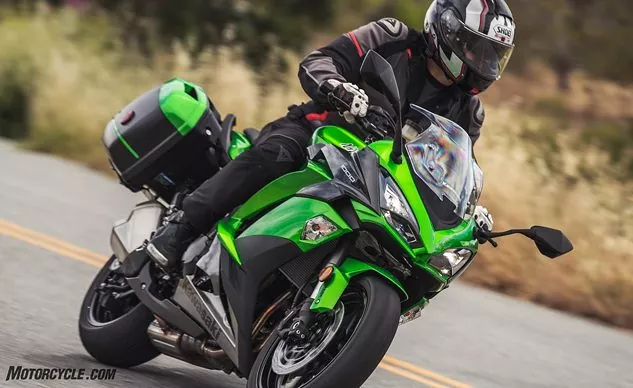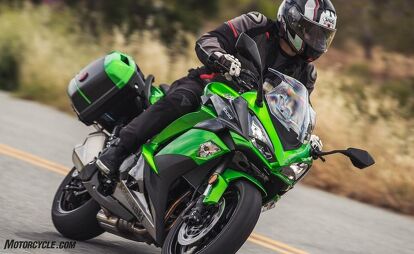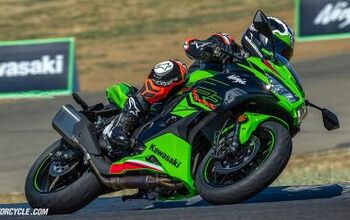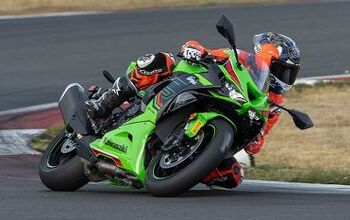2017 Kawasaki Ninja 1000 ABS Review - First Ride

Performance, style, and value all in one bike
In an era in which adventure-styled motorcycles seem to be taking over the sport-touring class, the 2017 Kawasaki Ninja 1000 ABS stands out as a great example of a traditional sport-tourer. Kawasaki has taken the heart of a sportbike and wrapped it with a package that can tackle almost any task a rider could want, from commuting to canyon scratching to touring to the occasional track day. Outfit it with the optional $1165 saddlebags, and you’ve got a mount that would be a great multi-state companion for less than $14,000.
2017 Kawasaki Ninja 1000 ABS
| Engine | 18.5/20 |
| Suspension/Handling | 13.0/15 |
| Transmission/Clutch | 8.5/10 |
| Brakes | 9.5/10 |
| Instruments/Controls | 4.5/5 |
| Ergonomics/Comfort | 8.5/10 |
| Appearance/Quality | 9.5/10 |
| Desirability | 9.0/10 |
| Value | 10/10 |
| Overall Score | 91/100 |
Touring the spec sheet
At first blush, one might be tempted to say that not too much has changed functionally in the 2017 update. Well, that’s both partially right and wrong. Yes, whole sections of the motorcycle remain mechanically the same, which points to the overall strength of the platform prior to the update. However, the changes were designed to improve specific areas of the Ninja 1000’s utility.
For example, the new bodywork looks like it was merely to bring it in line with the current Kawasaki sportbike family resemblance. This may be true and is fairly obvious when one looks at the chin spoiler which traces its heritage to the ZX-10R and H2. The aggressively angular headlights also point to shared DNA with the rest of Kawasaki’s sportbike line. For a touch of modern, the Ninja 1000’s headlights are now LED units which Kawasaki claims throws light 1.4 times further than last year’s halogens. The rest of the fairing is as utilitarian as it is swoopy. Up to 28mm wider in places, the fairing helps direct heat from the radiator away from the rider’s legs while also increasing the pocket of calmer air at speed. Like its ZX-6R brethren, the Ninja 1000’s turnsignals are built-in units which are significantly less bulbous when compared to the previous generation 1000.
The windscreen deserves a little special attention. It retains its three-position adjustability but gains 15mm in height and a double-bubble design. In its lower position, the line of clear air hits me mid-chest which is perfect for sport-riding in warm weather. In its highest position, the windscreen directs the air at the top of my shoulders providing additional protection in colder weather – a feature I was able to experience firsthand as our first-day ride featured a 50° temperature swing all the way up to 100°. Additionally, while not offering the massive protection of a more touring-oriented machine, the Ninja 1000’s screen helped make a 35-mph headwind much more bearable during a freeway drone on the second day of our ride. Kawasaki claims the windscreen helps to deliver 30% less wind drag to the rider’s body. Although Kawasaki’s lawyers recommend against it, the windscreen can be adjusted quickly on-the-fly but does require both hands – one to press the release below the instrument cluster and the other to lift/lower the windscreen.
Underneath that swoopy, new bodywork, the engine remains mechanically unchanged. Fed by cool air intakes on either side of the fairing, the 1,043cc engine puts out mountains of torque and mid-range power. Kawasaki claims it chose the 77.0mm x 56.0mm bore and stroke to deliver a specific engine character; I can say that its character is a kick in the pants.
For 2017, the ECU settings were revised for smoother throttle response and cleaner emissions. The power delivery feels directly connected to the rider’s right wrist with smooth, hiccup-free response, no matter what the input. I could tell you about the downdraft 38mm throttle bodies and how their oval sub-throttles help to make the engine slim, but really, once out on the open road, the hows and whys fail to matter anymore and are replaced with wows!
The big changes for the 2017 Ninja 1000 affect both power delivery and braking and come in the form of a Bosch Inertial Measurement Unit (IMU). Weighing in at just 40 grams, the IMU allows additional precision in both the Kawasaki Traction Control (KTRC) and the Kawasaki Intelligent anti-lock Brake System (KIBS). Using information gathered on five data points (longitudinal acceleration, transverse acceleration, vertical acceleration, roll rate, and pitch rate) plus a calculated yaw rate, the Kawasaki Cornering Management Function (KCMF) crunches those numbers and gives riders a helping hand with both acceleration and braking when needed.
Under acceleration, the KTRC can be set to one of three settings (plus off). Modes 1 and 2 are designed for maximum acceleration while mode three is designed to provide stability in slippery conditions. Over the bike’s two-day introductory ride, I left the KTRC set to 1. Although I never felt it intervene in a corner, I did feel it smoothly intercede on my behalf over a series of whoop-de-dos, first modulating front-wheel lift cresting a hill and then flashing the KTRC indicator as both wheels became slightly airborne on the next whoop. Good times.
When it comes to braking, the KCMF’s role is even more pronounced. While the KIBS is the same base system as on both the Ninja H2 and ZX-10R, the settings are specific to the Ninja 1000. The KCMF oversees the KTRC and KIBS with the goal of helping riders smooth their braking and accelerating forces. Its tracking of the IMU data helps it to determine when it is needed. For example, if a rider who is already in a turn notices that the radius is tightening up, requiring more slowing, the KIBS will intervene if the rider applies the brakes too abruptly and smooth out the hydraulic pressure, preventing the bike from standing up and running off line.
A few other small updates are also worth noting. The instrument cluster received a complete makeover. While retaining the large, central analog tachometer, the warning lights have been moved to a line down the left side of the cluster. The LCD portion to the right of the tachometer is a negative display, featuring white characters on a black background for improved visibility in all lighting conditions. The readout includes speedometer, odometer/dual tripmeters, clock, ambient/coolant temperature, fuel level, fuel range and average/instant fuel consumption. Additionally, gear indicator, power modes, and KTRC setting are also displayed.
Both the rider and passenger seats received updates. The rider’s seat has a new shape and updated foam, while the passenger’s seat is 25mm thicker and features a slight rise in the front of the padding to help prevent the passenger from sliding into the rider. The grab rail has been located slightly higher than before and contains the bag-mounting slots. The previous generation required that the grab rail be changed and the bodywork cut to accommodate the accessory bags.
Since I was flying solo at the introduction, I can’t comment on the comfort of the passenger, but the rider’s seat is hard enough to be uncomfortable long before a tankful of gas has been finished. The good news is that Kawasaki is also selling an accessory gel seat. My prediction is that the company will sell a bunch of them to Ninja 1000 buyers.
Where the rubber meets the road
Whether you love or hate its looks, the Ninja 1000’s exhaust puts out a pleasant growl at idle. The song continues, switching over to the resonator-augmented intake growl as the engine speed increases. With the previous generation 1000, we noted that the clutch engaged very early in the lever travel and was, on occasion, grabby. While the engagement is still early, the grabbiness has been exorcised, making clutch engagement buttery-smooth. Add that to the light pull of the slip/assist clutch, and you have a great mount for navigating the urban bump and grind. While we’re considering low-speed character, the engine is a pussycat that doesn’t unleash its claws until the rpm increase. Then look out!
On those occasions where you’re lucky enough to have enough open road in front of you to run the big Ninja up through redline for most of its gears, you’ll be greeted with a noticeable bump in power above 7,000 rpm but not the rocketship rush of, say, the ZX-10R. Still, the acceleration is open-class fast, just not mind-bendingly so. When it’s time to shift, a short throw of the left boot gets you into the next gear, which is surprisingly close to the previous one. I found this somewhat odd on a sport-touring bike that really has no racing intent. With the broad power delivery of the mill, I expected a larger gap between gears. This is not a complaint, but simply an observation.
When the time comes to slow down, the radial-mount monoblock calipers and the 300mm semi-floating petal discs get the job done, offering plenty of power and excellent feel. This level of feel in conjunction with the KIBS should allow riders to trail brake towards an apex with confidence. The wide handlebar gives the rider leverage to bend the Ninja 1000 into corners. Where the version we tested in 2014 had the tendency to understeer and required constant pressure on the inside grip to hold a line, the 2017 model has no such issues, and I credit the revised rear suspension settings and new linkage for this change. I could toss it into a corner and stop precisely at the lean angle I wanted, and the bike would stay on that line until I told it to do something different. Our route took us over one of my favorite remote central California highways, and when I got to the end, I wanted to turn around and go do it again. The Ninja 1000 was that much fun.
The only time the fun was interrupted was when the road/gear selection placed the tachometer into the 6,000–8,000 rpm range. While the high-frequency vibration is easy to ignore when you’re just powering through it, if you find yourself stuck in that range for more than a couple corners, you’ll find yourself hunting for the gearshift lever. Fortunately, the broad power delivery is amenable to running in a higher gear and just riding the torque curve. This vibration is really the only shortcoming of this amazingly fun powerplant. It has the ability to happily run from the bottom of the tachometer all the way to its rev-limit – which is a great feature for a sport-touring mount.
So what about the bags?
I’ll begin with my one complaint about the Ninja 1000’s bags. I don’t think they should be accessory items. Although the Ninja 1000 looks great without the bags, they are what make the bike a sport-tourer. According to Kawasaki, more than half of the 1000’s buyers choose to add the bags at the time of purchase. However, they can be ordered at a later date. Holding 28 liters per side, the saddlebags are color-matched, keyed to the ignition, and capacious enough to hold a full-face helmet. While the bags on the test unit I rode needed a light thwack on the side to mount/unmount the bags, I suspect that this would get easier with use. When mounted, the bags tuck in closely to the tail section, giving the rear of the bike a finished look. I wouldn’t even consider buying the Ninja 1000 without the bags.
For 2017, Kawasaki refined the Ninja 1000 in all the right places. The fairing clearly marks it as a member of the Ninja family. The electronic upgrades go about as far as possible without switching over to ride-by-wire (which explains the lack of cruise control). The only place where Kawasaki truly missed the mark is on the rider’s seat – an issue possibly remedied by the aftermarket or Kawasaki’s own accessory gel seat.
The Ninja 1000 is one of those bikes we’ve loved from the moment we first twisted its throttle – even with that 6,000–8,000 rpm buzz. At $12,199 (without bags), the Ninja 1000 compares more than favorably to the bikes featured in our recent BMW S1000XR Vs. KTM 1290 Super Duke GT Vs. MV Agusta Turismo Veloce for thousands less – even when the accessory bags are added to the out-the-door cost. All you’ll really be missing is the cruise control. If you’re in the market for a sport-touring motorcycle, you owe yourself a serious look at the 2017 Kawasaki Ninja 1000 ABS.
2017 Kawasaki Ninja 1000 ABS
+ Highs
- Killer engine!
- Looks great with or without bags
- Tremendous value
– Sighs
- Saddlebags are a $1,300 option
- Engine buzz between 6,000–8,000 rpm
- Hard seat
2017 Kawasaki Ninja 1000 ABS Specifications | |
|---|---|
| MSRP | $12,199.00 |
| Engine Type | 1043cc Inline Four, DOHC, 16-valve, Liquid-cooled |
| Bore and Stroke | 77.0 x 56.0mm |
| Compression Ratio | 11.8:1 |
| Fuel System | DFI w/38mm Keihin throttle bodies (4) and oval sub-throttles |
| Ignition | TCBI with digital advance |
| Rider Aids | Kawasaki Traction Control (KTRC), Kawasaki Intelligent anti-lock Brake System (KIBS), Power Mode, Kawasaki Corner Management Function (KCMF) |
| Transmission | 6-speed |
| Final Drive | Chain |
| Front Suspension | 41mm inverted cartridge fork with stepless compression and rebound damping, adjustable spring preload, 4.7 in travel |
| Rear Suspension | Horizontal monoshock with stepless rebound damping, remotely adjustable spring preload, 5.4 in. travel |
| Front Brake | Dual 300mm petal-type rotors with radial-mount 4-piston monobloc calipers and ABS |
| Rear Brake | Single 250mm petal-type rotor with single-piston caliper and AB |
| Front Tire | 120/70ZR17 |
| Rear Tire | 190/50 ZR17 |
| Rake/Trail | 24.5°/4.0 in. |
| Wheelbase | 56.7 in |
| Seat Height | 32.1 in. |
| Curb Weight (Claimed) | 516.0 lb. (ready to ride) |
| Fuel Capacity | 5.0 gal. |
| Colors | Candy Lime Green/Metallic Carbon Gray,Metallic Spark Black/Metallic Graphite Gray |
| Warranty | 12 Month Limited Warranty |

Like most of the best happenings in his life, Evans stumbled into his motojournalism career. While on his way to a planned life in academia, he applied for a job at a motorcycle magazine, thinking he’d get the opportunity to write some freelance articles. Instead, he was offered a full-time job in which he discovered he could actually get paid to ride other people’s motorcycles – and he’s never looked back. Over the 25 years he’s been in the motorcycle industry, Evans has written two books, 101 Sportbike Performance Projects and How to Modify Your Metric Cruiser, and has ridden just about every production motorcycle manufactured. Evans has a deep love of motorcycles and believes they are a force for good in the world.
More by Evans Brasfield

















































Comments
Join the conversation
All those electronics and no cruise control? Me no understand. Why factory CC is not standard (at least an option) on any decent sized "ride by wire" bike these days puzzles me. Cars have had it for ages.
My Geico insurance for a new 2017 Ninja 1000 is $297.00 a year with full coverage, but I am 59 years old with no tickets and I ride extremely safe, and I have 36 years of experience. You should always ride like you are INVISIBLE!